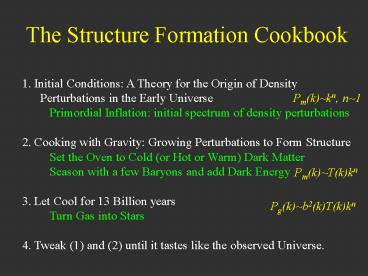The Structure Formation Cookbook - PowerPoint PPT Presentation
Title:
The Structure Formation Cookbook
Description:
1. Initial Conditions: A Theory for the Origin of Density Perturbations in the Early Universe Primordial Inflation: initial spectrum of density perturbations – PowerPoint PPT presentation
Number of Views:120
Avg rating:3.0/5.0
Title: The Structure Formation Cookbook
1
The Structure Formation Cookbook
1. Initial Conditions A Theory for the Origin of
Density Perturbations in the Early
Universe Primordial Inflation initial
spectrum of density perturbations 2. Cooking
with Gravity Growing Perturbations to Form
Structure Set the Oven to Cold (or Hot
or Warm) Dark Matter Season with a few
Baryons and add Dark Energy 3. Let Cool for 13
Billion years Turn Gas into Stars
4. Tweak (1)
and (2) until it tastes like the observed
Universe.
Pm(k)kn, n1
Pm(k)T(k)kn
Pg(k)b2(k)T(k)kn
2
Growth of Large-scale Structure Robustness of
the paradigm recommends its use as a Dark Energy
probe Price additional cosmological and
structure formation parameters Bonus additional
structure formation parameters
3
w 1
Growth of Density Perturbations
Volume Element
Flat, matter-dominated
- w -0.7
Raising w at fixed WDE decreases growth rate of
density perturbations and decreases volume
surveyed
4
Sensitivity to Dark Energy equation of state
peaks at modest redshift
Volume element
Comoving distance
Huterer Turner
5
Clusters of Galaxies
- Clusters of galaxies are the largest
gravitationally virialized objects in the
Universe M1013-1015 Msun - 50-90 of their baryonic mass is in the form of
intracluster gas - The gas is heated as it collapses into the
clusters gravitational potential well to
temperatures of Tgas 107-108 K - The hot intracluster gas emits X-rays and causes
the Sunyaev-Zeldovich (SZ) effect
6
Clusters form hierarchically
z 7
z 5
z 3
dark matter
time
z 0.5
z 0
z 1
Kravtsov
5 Mpc
7
Clusters and Dark Energy
Number of clusters above observable mass threshold
- Requirements
- Understand formation of dark matter halos
- Cleanly select massive dark matter halos (galaxy
clusters) over a range of redshifts - Redshift estimates for each cluster
- Observable proxy that can be used as cluster mass
estimate - p(OM,z)
- Primary systematic
- Uncertainty in bias scatter of mass-observable
relation
Dark Energy equation of state
Mohr
Volume Growth (geometry)
8
Theoretical Abundance of Dark Matter Halos
Warren etal
9
Cluster Mass Function
Tinker, Kravtsov et al. 2008, ApJ 688, 709
10
Clusters and Dark Energy
Number of clusters above observable mass threshold
- Requirements
- Understand formation of dark matter halos
- Cleanly select massive dark matter halos (galaxy
clusters) over a range of redshifts - Redshift estimates for each cluster
- Observable proxy that can be used as cluster mass
estimate - p(OM,z)
- Primary systematic
- Uncertainty in bias scatter of mass-observable
relation
Dark Energy equation of state
Mohr
Volume Growth (geometry)
11
Cluster Selection
- 4 Techniques for Cluster Selection
- Optical galaxy concentration
- Weak Lensing
- Sunyaev-Zeldovich effect (SZE)
- X-ray
- Cross-compare selection to control systematic
errors
12
Holder
13
Cluster Scaling Relations
Relations between observable integrated
properties of intracluster gas and cluster mass
are expected and observed to be tight, but the
amplitude and slope are affected by galaxy
formation physics
simulation
Total cluster mass
SZ signal
Nagai 2005 Kravtsov, Vikhlinin, Nagai 2006, ApJ
650, 128
pressure Y gas mass x temperature
NSF Site Visit May 18 - 19, 2009
14
Cluster SZ Studies
- Examine clusters at high angular resolution
- Compare many probes to calibrate SZ signal
Simulated Merging Cluster
SZA
SZACARMA
Nagai, Kravtsov, Vikhlinin (2007)
15
Clusters and Dark Energy
Number of clusters above observable mass threshold
- Requirements
- Understand formation of dark matter halos
- Cleanly select massive dark matter halos (galaxy
clusters) over a range of redshifts - Redshift estimates for each cluster
- Observable proxy that can be used as cluster mass
estimate - p(OM,z)
- Primary systematic
- Uncertainty in bias scatter of mass-observable
relation
Dark Energy equation of state
Mohr
Volume Growth (geometry)
16
Photometric Redshifts
Redshifted Elliptical galaxy spectrum
Measure relative flux in multiple
filters track the 4000 A break Precision
is sufficient for Dark Energy probes,
provided error distributions well measured.
17
Galaxy Photo-z Simulations
VHS
DES griz
DES
DES griZY VHS JHKs on ESO VISTA 4-m enhances
science reach
10? Limiting Magnitudes g 24.6 r 24.1
i 24.0 z 23.9 2 photometric
calibration error added in quadrature
J 20.3 H 19.4 Ks 18.3
Z 23.8 Y 21.6
Vista Hemisphere Survey
18
Clusters and Dark Energy
Number of clusters above observable mass threshold
- Requirements
- Understand formation of dark matter halos
- Cleanly select massive dark matter halos (galaxy
clusters) over a range of redshifts - Redshift estimates for each cluster
- Observable proxy that can be used as cluster mass
estimate - p(OM,z)
- Primary systematic
- Uncertainty in bias scatter of mass-observable
relation
Dark Energy equation of state
Mohr
Volume Growth (geometry)
19
Precision Cosmology with Clusters?
- Effect of
- Uncertainty in
- mass-observable
- relation
Mass threshold
20
Cluster Mass Estimates
- 4 Techniques for Cluster Mass Estimation
- Optical galaxy concentration
- Weak Lensing
- Sunyaev-Zeldovich effect (SZE)
- X-ray
- Cross-compare these techniques to reduce
systematic errors - Additional cross-checks
- shape of mass function cluster
- correlations (Lima Hu)
21
Cluster Clustering
Clustering amplitude constrains cluster mass































